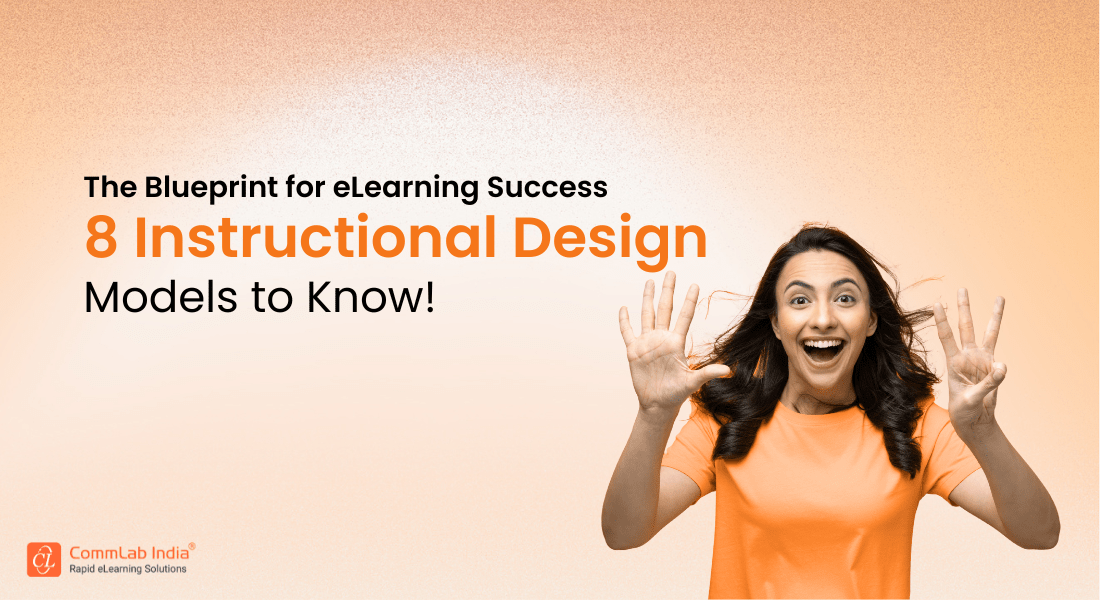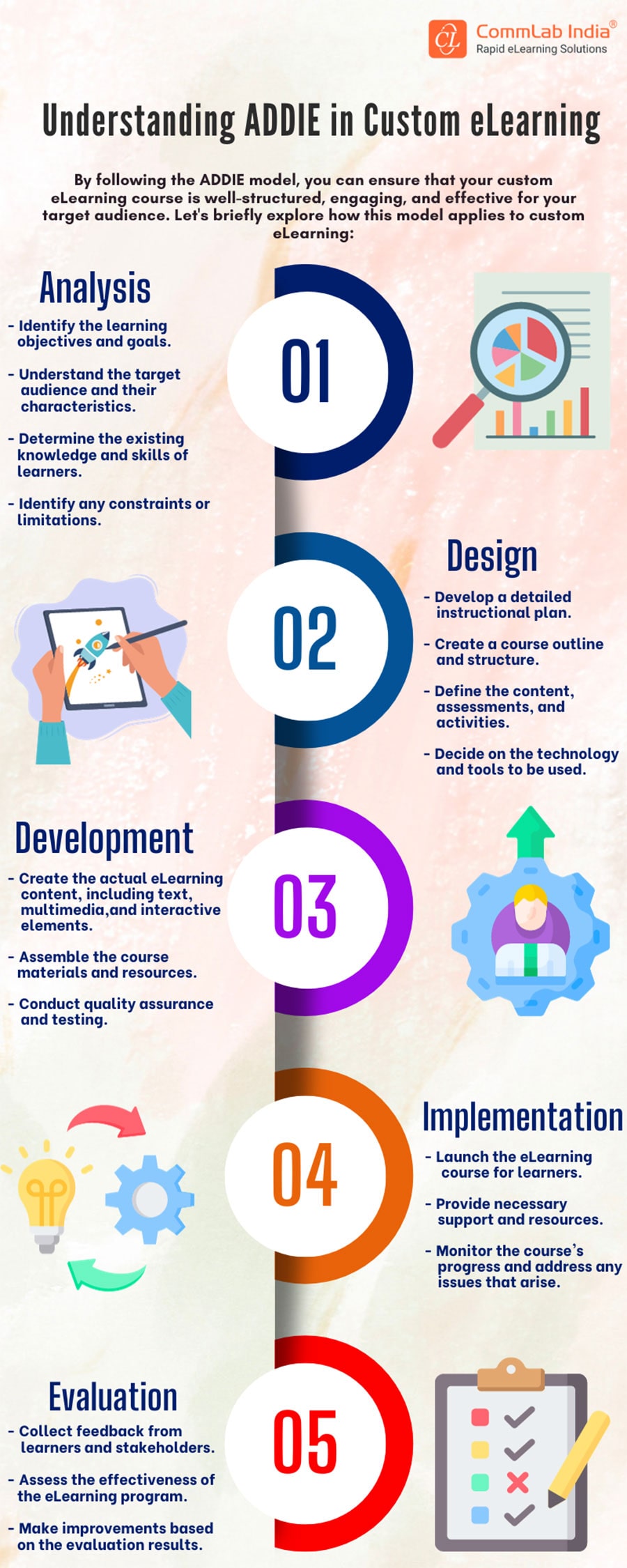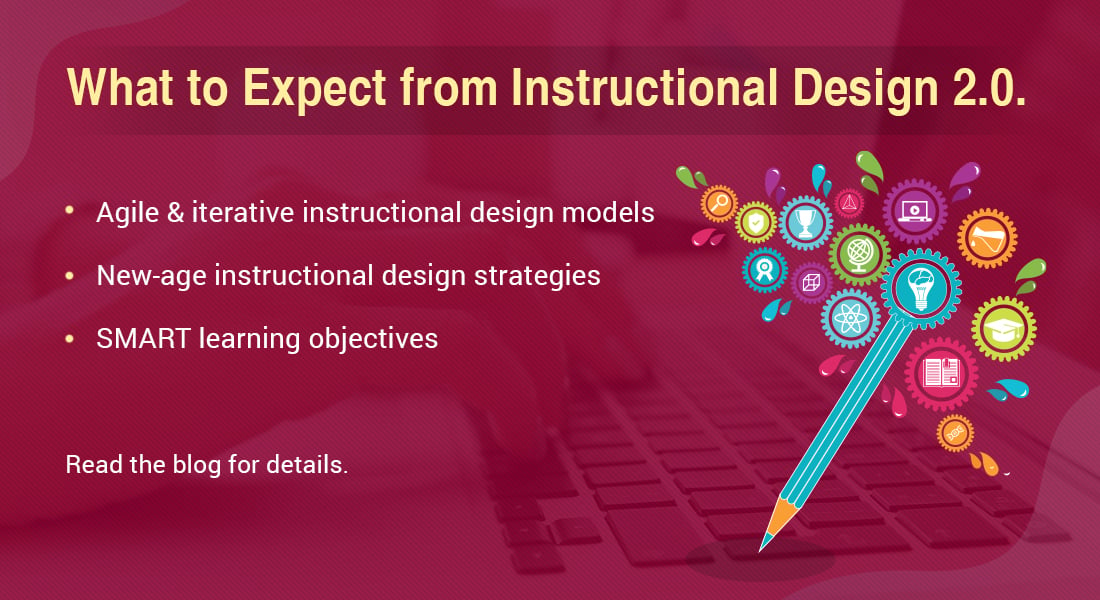What is an Instructional Design Model? A Guide to 8 Powerful ID Models for Learning Success

In the evolving world of Learning and Development (L&D), designing effective corporate training programs requires more than just subject matter expertise—it demands structure, strategy, and purpose. This is where Instructional Design (ID) models come into play. But what exactly are they? Let’s take a closer look at ID models and explore eight of the most influential ones: ADDIE, Kemp, Dick and Carey, ASSURE, SAM, Hannafin and Peck, Waterfall, and Rapid Prototyping. Whether you're an experienced instructional designer or just stepping into the field, understanding these models will equip you with the tools to design smarter, train better, and drive meaningful learning outcomes.
Table Of Content
What is an Instructional Design Model?
An instructional design (ID) model is a systematic framework used to plan, develop, implement, and evaluate learning experiences. These models provide a step-by-step approach to ensure that training is not only aligned with learning objectives but also engaging, measurable, and tailored to the needs of the learners. In essence, an instructional design model helps translate learning goals into structured, impactful, and scalable learning interventions.
Instructional Design models play a critical role in the eLearning development process, serving as structured blueprints that guide the creation of effective, engaging, and goal-oriented learning experiences. These models help instructional designers systematically analyze learner needs, define clear learning objectives, and design content that aligns with those goals. By following an ID model, designers can visualize the overall structure of a course, ensuring that all essential elements—such as assessments, multimedia, interactivity, and feedback mechanisms—are intentionally planned and integrated.
More importantly, ID models help maintain instructional quality and consistency, especially in large-scale or complex corporate training programs. Research by organizations like ATD consistently shows that applying structured instructional design frameworks improves training effectiveness and learner satisfaction. Models like ADDIE, SAM, or ASSURE not only offer a roadmap for development but also embed evaluation phases to measure effectiveness and drive continuous improvement.
In essence, an instructional design model is more than a planning tool—it’s a strategic framework that connects learner needs with measurable performance outcomes, ensuring that training delivers real value to both the learner and the organization.

Instructional Design 101
A Handy Reference Guide for eLearning Designers
- eLearning standards
- Streamlined instructional design process
- Effective assessments
- And More!
What Are the Different Instructional Design Models?
A Quick Look at Popular Instructional Design Models
Choosing the right instructional design model can make or break your learning experience. Here are some of the most widely used models:
- ADDIE Model
- Kemp Model
- Dick and Carey Model
- ASSURE Model
- SAM Model
- Hannafin and Peck Model
- Waterfall Model
- Rapid Prototyping Model
Whether you're building a virtual onboarding program, designing compliance modules, or developing interactive eLearning courses, instructional design models offer the blueprint that guides each stage —from analyzing learner needs to evaluating performance outcomes.
There are numerous ID models available, each with its own unique strengths and practical applications. Some, like the ADDIE model, provide a linear, structured approach that is suitable for most traditional training environments and projects requiring detailed planning. Others, such as SAM or Rapid Prototyping, offer agile, iterative methods that are ideal for fast-paced development cycles, where continuous feedback and rapid revisions are essential. Meanwhile, models like Kemp, Dick and Carey, or ASSURE bring a focus on systems thinking, learner engagement, or technology/media integration, depending on the specific needs and goals of the learning experience. Each model serves as a strategic framework, helping instructional designers create more effective, efficient, and learner-centered training solutions.
Let’s explore a range of instructional design models.
1. ADDIE Model (Analysis, Design, Development, Implementation, Evaluation Model)
The ADDIE model is one of the most widely adopted instructional design frameworks in both corporate training and academic environments. Originally developed by the U.S. military in the 1970s, it offers a structured yet flexible approach that divides the instructional design process into five key phases: Analysis, Design, Development, Implementation, and Evaluation. Each phase builds on the previous one while allowing for iterations and refinements, making the model highly adaptable to various project scopes and timelines.
Have a glance at the phases of the ADDIE instructional design model in a visually appealing way with this infographic.
Phases of the ADDIE Model
Let’s explore each phase in a detailed way:
- Analysis: The Analysis phase helps identify what learners need to know, what skills they lack, and who they are. It also looks at the learning environment, available tools, and the >organization’s goals. This step sets the foundation for designing relevant and effective training.
Output: Training needs document or gap analysis. - The Design phase involves defining clear learning objectives and choosing the best strategies to deliver the content. It includes planning assessments like pre- and post-tests, creating storyboards to map out the course, and selecting media elements such as videos or visuals to support learning.
Output: A detailed design document with the course structure, objectives, and content plan. - Development: The Development phase involves creating the actual learning materials. This includes building eLearning modules, job aids, and simulations, while integrating multimedia elements like videos, animations, and interactive features. The goal is to turn the design plan into a working course that is engaging and ready for testing.
Output: Complete courseware or a functional prototype. - Implementation: The Implementation phase involves rolling out the training to learners through an LMS, virtual platforms, or in-person sessions. It includes preparing facilitators, setting up access, and handling all logistics to ensure a smooth launch.
Output: A live and accessible training solution. - Evaluation: The evaluation phase ensures the training is effective and meets its goals. Formative evaluation happens during development, allowing for continuous feedback and improvements. Summative evaluation takes place after the course is launched, using tools like Kirkpatrick’s Levels, surveys, or performance data to measure impact. The results are compiled into reports that provide insights into learner performance and help improve future training.
Discover how to measure the success of your corporate training programs using Kirkpatrick’s Model in this quick and insightful video!
Output: Evaluation reports and learner performance insights.
ADDIE is structured but adaptable, suitable for both simple and complex learning programs. Its iterative nature allows for updates at every stage, ensuring content stays relevant and effective. Widely supported by instructional design tools and methodologies, ADDIE remains a cornerstone model in modern L&D practices.
2. Kemp Model
The Kemp Model, developed by Jerrold Kemp, adopts a non-linear, learner-centric approach to instructional design. Unlike traditional step-by-step models, Kemp encourages designers to consider multiple elements simultaneously—such as learner characteristics, content structure, instructional strategies, and delivery methods. This flexible design process makes it especially effective for complex training environments involving diverse audiences, multiple delivery platforms, or cross-functional teams.
Key Elements of the Kemp Model:
- Instructional Problems: Identify the core performance gaps or knowledge deficiencies that the training aims to address.
- Learner Characteristics: Analyze the target audience, including demographics, learning preferences, prior knowledge, and technical proficiency to ensure learner-centric content.
- Task Analysis: Break down the overall learning goals into specific tasks and sub-skills required for learner success.
- Instructional Objectives: Define clear, measurable learning outcomes that guide the course structure and assessment strategy.
- Content Sequencing: Organize the content in a logical progression, typically from simple to complex, to support effective learning.
- Instructional Strategies: Choose appropriate teaching methods, such as case studies, role plays, or simulations, based on content and learner needs.
- Message Design: Plan how content will be communicated using effective tone, visuals, structure, and layout to enhance comprehension and engagement.
- Delivery Methods: Select suitable platforms and formats for content delivery—such as LMS, mobile apps, webinars, or instructor-led training.
- Evaluation Instruments: Design formative and summative assessments to measure learner progress, content effectiveness, and areas for improvement.
Discover how to design effective assessments that align perfectly with your learning objectives in this video!
The Kemp Model stands out for its adaptability and holistic focus. By allowing designers to address various instructional elements in parallel, it supports continuous iteration and aligns instructional strategies with real-world learner needs. This makes it particularly valuable for blended learning programs, large-scale corporate rollouts, and projects with multiple delivery modes or stakeholder inputs.
3. Dick and Carey Model
The Dick and Carey Model adopts a systematic, systems-oriented approach to instructional design. Rather than viewing instruction as a linear sequence, it treats it as a set of interdependent components that must work in harmony. The model emphasizes strong alignment between learning goals, instructional strategies, and assessments, making it particularly effective for technical, compliance, or performance-based training where precision and accountability are critical.
Key Phases of the Model
- Instructional Goals: Define broad, high-level objectives based on thorough needs analysis. These goals establish the foundation for all subsequent design decisions.
- Instructional Analysis: Break down instructional goals into detailed sub-skills, tasks, and concepts that learners must master.
- Learner and Context Analysis: Examine learners’ entry behaviors, prior knowledge, learning preferences, and the context in which learning will occur (e.g., physical setting, available technology).
- Performance Objectives: Create specific, measurable objectives that clearly state what learners should be able to do and under what conditions. These objectives are derived from the instructional analysis.
- Assessment Instruments: Design assessments that directly measure the achievement of the performance objectives. These may include quizzes, tests, demonstrations, or practical tasks.
- Instructional Strategy: Plan instructional methods for delivering content, facilitating practice, and maintaining learner engagement. Strategies often include guided instruction, active learning, and feedback loops.
- Instructional Materials: Develop or select appropriate learning materials such as SCORM-compliant eLearning modules, manuals, handouts, or simulations, ensuring alignment with both objectives and strategy.
- Formative Evaluation: Conduct evaluations during the design and development phases with a small sample of learners or SMEs. This helps identify and correct issues early.
- Revision: Refine and revise instructional materials and strategies based on formative evaluation results to improve quality and effectiveness.
- Summative Evaluation: After full implementation, conduct a comprehensive evaluation to determine the overall effectiveness of the instruction in achieving its goals. This includes learner performance data, feedback, and ROI analysis.
The Dick and Carey Model provides a clear, evidence-based framework for designing instruction that is measurable, repeatable, and scalable. By emphasizing rigorous goal alignment and continuous evaluation, it ensures that learning interventions are not only instructionally sound but also tied to organizational performance outcomes. Though structured, the model allows for iterative improvements, making it a reliable choice for formal training environments where learning must be accountable and results-driven.
Related Read: E-learning Instructional Design Approaches - Dick & Carey
4. ASSURE Model
The ASSURE model is a structured instructional design framework that emphasizes the effective integration of technology and media into the learning experience while maintaining a strong focus on learner characteristics and active engagement. Originally developed for classroom use, it is particularly well-suited for blended learning, flipped classrooms, and multimedia-rich environments, making it a popular choice among both educators and corporate trainers.
Key Phases of the Model
- Analyze Learners: This phase involves a deep dive into understanding who the learners are. Factors such as prior knowledge, learning preferences, cultural background, technological proficiency, and motivational levels are assessed. This analysis ensures that the instructional approach is tailored to the audience, setting the foundation for learner-centric design.
- State Objectives: Once the learner profile is clear, specific and measurable learning objectives are defined. These objectives should be aligned with business goals and clearly articulate what learners will be able to do after completing the instruction. Using performance-based verbs (e.g., define, demonstrate, apply) ensures clarity and evaluation readiness.
- Select Methods, Media, and Materials: In this step, instructional designers or facilitators select the most appropriate delivery methods, instructional design strategies, and media tools —ranging from videos and podcasts to simulations and physical materials. The key is to match the chosen tools to both learner needs and content type for maximum engagement and effectiveness.

- Utilize Media and Materials: Here, the selected media and materials are prepared and deployed. This includes organizing logistics, setting up technologies, and rehearsing delivery (especially for instructor-led sessions). The goal is to ensure smooth and professional execution of the learning experience.

Instructional Design 101
A Handy Reference Guide for eLearning Designers
- eLearning standards
- Streamlined instructional design process
- Effective assessments
- And More!
- Require Learner Participation: Active participation is essential for retention and skill application. This phase involves designing opportunities for learners to interact with the content, such as through discussions, simulations, case studies, or self-paced exercises. These activities enhance engagement and help bridge the gap between knowledge and real-world application.
- Evaluate and Revise: The final phase ensures the effectiveness of the instruction through formative and summative assessments. Feedback is collected via assessments, surveys, or performance data, and the insights gained are used to revise and improve future iterations of the training or course.
The ASSURE model is ideal for instructional designers seeking a learner-focused and media-integrated approach. Its step-by-step process promotes instructional alignment, learner engagement, and continuous improvement, making it highly adaptable for today's digital and hybrid learning landscapes.
Instructional Design Models Comparison Chart
|
Model |
Main Focus |
Phases/Steps |
Best For |
|
ADDIE |
Systematic and sequential design |
Analyze, Design, Develop, Implement, Evaluate |
Traditional training development |
|
Kemp |
Holistic and non-linear |
Instructional problems, learner characteristics, task analysis, instructional objectives, content sequencing, strategies, delivery, evaluation, support services |
Projects requiring flexibility and learner-centered design |
|
Dick and Carey |
Systems approach to instruction |
Identify goals, conduct instructional analysis, learner and context analysis, write objectives, assessments, instructional strategy, materials, formative evaluation, revision, summative evaluation |
Complex, large-scale instructional projects |
|
ASSURE |
Focused on integrating technology and media |
Analyze learners, State objectives, Select methods/media/materials, Utilize media/materials, Require learner participation, Evaluate and revise |
Classroom instruction, tech-enhanced training |
|
SAM (Successive Approximation Model) |
Agile development and rapid iterations |
Preparation, Iterative Design, Iterative Development |
eLearning, fast-paced corporate training |
|
Hannafin and Peck |
Developmental process emphasizing continuous evaluation |
Needs assessment, Design, Development and implementation |
Problem-based learning, adaptive content |
|
Waterfall |
Sequential, traditional software development model |
Requirements, Design, Implementation, Verification, Maintenance |
Projects with fixed requirements and timelines |
|
Rapid Prototyping |
Build early version to test and refine |
Design, Prototype, Review, Refine |
Projects with unclear requirements or need for quick delivery |
5. SAM Model (Successive Approximation Model)
The SAM (Successive Approximation Model), created by Michael Allen, offers an agile, iterative approach to instructional design. Unlike traditional linear models, SAM emphasizes collaboration, rapid prototyping, and continuous feedback. This makes it especially effective for fast-paced corporate environments, where flexibility, creativity, and speed are essential.
Phases of the SAM Model
- Preparation Phase: This phase begins with kick-off meetings to gather essential information from stakeholders and subject matter experts (SMEs). The goal is to clearly define the project scope, constraints, audience, and goals. It sets the foundation for a collaborative and agile development process by aligning expectations early.
- Iterative Design Phase: In this phase, the team brainstorms ideas and builds low-fidelity prototypes—basic sketches or mock-ups of the learning solution. These early prototypes are shared with stakeholders to collect immediate feedback, which helps in refining the design before full development begins. This phase encourages creativity and user-centered thinking.
- Iterative Development Phase: Here, the course is developed in repeated cycles or versions. Each version is tested with users, feedback is gathered, and continuous improvements are made. This iterative cycle continues until the solution meets the desired quality and learning outcomes, ensuring that the final product is well-aligned with both learner needs and business objectives.
One of the primary strengths of the SAM model is its agile and flexible nature, which makes it particularly well-suited for fast-paced corporate environments and dynamic project timelines. By promoting early and frequent collaboration with stakeholders, SAM ensures that the learning solution evolves in alignment with business needs and learner expectations. Its emphasis on rapid prototyping and continuous feedback allows instructional designers to identify and resolve design issues early in the process, reducing the risk of major rework during the later stages of development. This iterative approach not only speeds up development cycles but also improves the overall quality of the final product. Additionally, SAM encourages creative problem-solving and innovation, giving designers the freedom to experiment, adapt, and refine their ideas in response to real-time feedback and user input.
Related Read: SAM - Why is it the Preferred Model for eLearning Development?
6. Hannafin and Peck Model
The Hannafin and Peck Model is a learner-centered instructional design framework grounded in constructivist learning theory. It emphasizes real-world problem-solving, exploration, and reflection, making it particularly well-suited for scenario-based training, simulation-driven instruction, and environments where learner engagement and autonomy are key.
Phases of the Hannafin and Peck Model
- Needs Assessment: This phase involves conducting interviews, surveys, observations, and analyzing existing data to identify specific training gaps and define the real-world context of the instructional problem. It ensures that the solution addresses what learners truly need to know or do differently.
- Design: Using the insights gathered, instructional designers establish clear learning goals, select instructional strategies, and craft learning environments that encourage exploration, problem-solving, and open-ended inquiry. Scenarios and simulations are often embedded to mirror realistic challenges.
- Development and Implementation: Designers create media-rich, interactive content, such as case-based learning modules, simulations, or branching scenarios. This content is then deployed, tested, and iteratively refined based on learner input and performance data.
The Hannafin and Peck Model stands out for its constructivist foundation, promoting learner autonomy, critical thinking, and deep engagement through real-world tasks. It is particularly well-suited for scenario-based and simulation-driven training, where learners explore open-ended problems rather than follow linear content. A defining feature of the model is its iterative nature —evaluation and revision are not confined to the end but occur continuously across all three phases, allowing instructional designers to adapt the content based on ongoing learner feedback and performance. This makes it highly effective in dynamic, inquiry-based learning environments where flexibility is essential. The model is frequently applied in leadership development programs, decision-making simulations, and complex problem-solving workshops, especially in sectors like healthcare, education, and corporate training that benefit from reflective, real-world application.

Instructional Design 101
A Handy Reference Guide for eLearning Designers
- eLearning standards
- Streamlined instructional design process
- Effective assessments
- And More!
7. Waterfall Model
Borrowed from software development, the Waterfall model offers a sequential, phase-based approach to instructional design. It is best suited for projects with fixed requirements and timelines, such as compliance training or government-regulated instruction. While it lacks flexibility, it excels in structured, large-scale deployments where detailed planning and documentation are essential.
Phases of the Waterfall Model
- Requirements: Gather and document detailed specifications from stakeholders, including audience profiles, learning objectives, scope, delivery platforms, and success criteria.
- Design: Create storyboards, scripts, and navigation flows to map out the full course experience from start to finish.
- Implementation: Develop all course materials, including multimedia assets, assessments, and interactivities, using appropriate authoring tools.
- Integration and Testing: Upload the course into the LMS or testing environment. Conduct rigorous QA testing for interactivity, functionality, and navigation.
- Deployment: Launch the final course to the intended learners, complete with facilitator guides, learner support, and tracking systems.
- Maintenance: Periodically update the course content to reflect changes in policies, procedures, tools, or technology.
The Waterfall model is highly effective for projects that require predictability, thorough documentation, and minimal change after launch. However, it may not be the best fit for agile environments where iterative feedback and flexibility are critical. When applied in the right context, it provides clarity, structure, and control —making it a strong choice for high-stakes or regulatory training initiatives.
8. Rapid Prototyping Model
The Rapid Prototyping Model is centered on the principle of "build fast, test often." Instead of investing extensive time in detailed upfront planning, this model emphasizes the rapid creation of a functional prototype—a simplified version of the course—which is continuously refined through iterative feedback. It is particularly effective for developing minimum viable products (MVPs), pilot modules, and demo-based training, where early validation is critical.
Phases of the Rapid Prototyping Model
- Planning and Needs Assessment: This initial phase focuses on identifying business goals, learner profiles, training constraints and context. While the research here is streamlined, it is still meaningful, providing enough information to proceed quickly and with purpose.
- Design and Develop Prototype: Instructional designers then build a rough version of the learning solution. This may include a few key screens, basic navigation paths, sample content and placeholder interactivity. The prototype serves as a visual and functional representation of the final product, helping stakeholders grasp the learning experience early in the process.
- Test with Learners/Stakeholders: Once the prototype is developed, it is shared with SMEs (Subject Matter Experts) and a sample group of learners. Feedback is gathered on usability, clarity, content accuracy, and learner engagement, allowing the team to spot and address issues early.

- Revise and Finalize: In this final phase, feedback from the testing stage is used to refine content, improve user interactions, add missing elements and polish navigation and visuals. The result is a deployment-ready solution that has already gone through real-world testing, reducing the risk of costly revisions later
Rapid Prototyping is highly valued for its agile and time-efficient approach, allowing instructional designers to prioritize speed and adaptability over extensive documentation. Instead of following a rigid, linear process, teams can move quickly from concept to prototype, making it ideal for projects with tight deadlines or rapidly changing requirements. Another key advantage is its user-focused design. By involving stakeholders and sample learners early in the process, feedback is collected when it’s most impactful—during the development of the initial prototype. This ensures better alignment with learning goals and enhances overall learner engagement.
These models are either prescriptive or adaptive. Prescriptive models prescribe particular solutions for particular learning needs. Descriptive models on the other hand, clearly define the components of design. Models such as ADDIE and Kemp follow a linear approach where the completion of one step is logically followed by the next step. The SAM model follows an agile approach for e-learning development which allows designers to create and refine prototypes repeatedly, with inputs from the client. In this iterative approach, ideas and assumptions are discussed and tested during the early stages. This allows for the quick development of a product with minimum iterations.
Instructional design models should not be viewed as rigid templates, but rather as adaptive frameworks. When applied with critical thinking and creativity, they support rather than hinder innovation—and remain a powerful asset in the instructional designer’s toolkit.
Wrapping up!
Instructional design models serve as the backbone for creating impactful eLearning courses, guiding instructional designers in developing effective and engaging corporate training content. By leveraging the right methods, techniques, and tools, instructional designers can empower learners and drive meaningful outcomes. But designing exceptional eLearning content requires more than just understanding ID models—it’s about aligning them with the right standards, instructional design strategies, and eLearning assessments to truly make a difference.
Ready to take your instructional design skills to the next level? Download our free eBook to explore the most relevant eLearning standards, proven ID strategies, and techniques for evaluating learner success. Start creating eLearning courses that truly inspire and deliver results!







![Using AI Language Models for eLearning [Infographic]](https://blog.commlabindia.com/hubfs/blogs/elearning-using-ai-language-models-infographic.jpg)